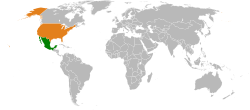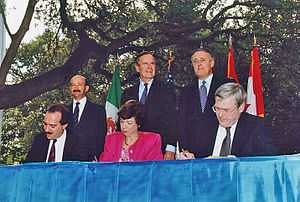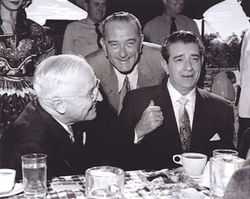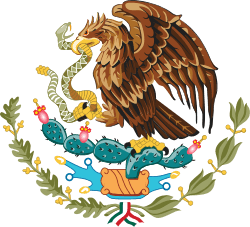Mexico–United States relations
 |
|
Mexico |
United States |
|---|---|
| Diplomatic Mission | |
| Embassy of Mexico, Washington, D.C. | Embassy of the United States, Mexico City |
Mexico–United States relations refers to the foreign relations between the United Mexican States and the United States of America. The two countries share a maritime and land border in North America. Several treaties have been concluded between the two nations bilaterally, such as the Gadsden Purchase, and multilaterally, such as the North American Free Trade Agreement. Both are members of various international organizations, including the Organization of American States and the United Nations.
The two countries have close economic ties, being each other's first and third largest trading partners. In 2010, Mexico's exports totaled US$309.6 billion, and almost three quarters of those purchases were made by the United States.[1] They are also closely connected demographically, with over one million U.S. citizens living in Mexico and Mexico being the largest source of immigrants to the United States. Illegal immigration and illegal trade in drugs and in fire arms have been causes of differences but also of cooperation.
While condemning the terrorist attacks of 9/11 and providing considerable relief aid to the U.S. after Hurricane Katrina, the Mexican government, pursuing neutrality in international affairs, opted not to actively join the controversial War on Terror and the even more controversial Iraqi War, instead being the first nation in history to formally and voluntarily leave the Inter-American Treaty of Reciprocal Assistance in 2002,[2] though Mexico later joined the U.S. in supporting military intervention in the Libyan Civil War.[3]
According to a 2010 Gallup poll, 4.4% of surveyed Mexicans, roughly 6.2 million people, say that they would move permanently to the United States if given the chance,[4] and according to the 2012 U.S. Global Leadership Report, 37% of Mexicans approve of U.S. leadership, with 27% disapproving and 36% uncertain.[5] As of 2013, Mexican students form the 9th largest group of international students studying in the United States, representing 1.7% of all foreigners pursuing higher education in America.[6]
History

The United States of America shares a unique and often complex relationship with the United Mexican States. With shared history stemming back to the Texas Revolution (1835–1836) and the Mexican–American War (1846–1848), several treaties have been concluded between the two nations, most notably the Gadsden Purchase, and multilaterally with Canada, the North American Free Trade Agreement (NAFTA). Mexico and the United States are members of various international organizations, such as the Organization of American States and the United Nations. Boundary disputes and allocation of boundary waters have been administered since 1889 by the International Boundary and Water Commission, which also maintains international dams and wastewater sanitation facilities. Once viewed as a model of international cooperation, in recent decades the IBWC has been heavily criticized as an institutional anachronism, by-passed by modern social, environmental and political issues.[7] Illegal immigration, arms sales, and drug smuggling continue to be contending issues in 21st-century U.S.-Mexico relations.
Early history
U.S.-Mexico relations grew out of the earlier relations between the fledgling nation of the United States and the Spanish Empire. Modern Mexico formed the core area of the Viceroyalty of New Spain at the time the United States gained independence from Great Britain in the American Revolutionary War (1775–1783). Spain had served as an ally to the American colonists in that war.
The aspect of Spanish-American relations that would bear most prominently on later relations between the U.S. and Mexico was the ownership of Texas. In the early 19th century the United States claimed that Texas was part of the territory of Louisiana, and therefore had been rightfully acquired by the United States as part of the Louisiana Purchase from France in 1803. The Spanish, however, claimed it was not, as the western boundaries of Louisiana were not clearly defined.[8] In 1819 the dispute was resolved with the signing of the Adams–Onís Treaty, in which the United States relinquished its claims to Texas and instead purchased Spanish Florida.[9]

In 1821 Mexico finally gained independence from Spain, and was soon recognized by the United States.[10] The two countries quickly established diplomatic relations.[11] In 1828 Mexico and the United States confirmed the boundaries established by the Adams–Onís Treaty by concluding the Treaty of Limits, but certain elements in the United States were greatly displeased with the treaty, as it relinquished rights to Texas.[12] Texas remained a focal point of U.S-Mexico relations for decades. The relationship was further affected by internal struggles within the two countries: in Mexico these included concerns over the establishment of a centralized government, while in the United States it centered around the debate over the expansion of slavery.[12]
Beginning in the 1820s Americans and other non-Mexicans began to settle in eastern Texas in large numbers. These settlers, known as Texians, were frequently at odds with the Mexican government. Their disagreements led to the Texas Revolution, one of a series of independence movements that came to the fore following the 1835 amendments to the Constitution of Mexico, which substantially altered the governance of the country. Prior to the Texas Revolution the general public of the United States was indifferent to Texas, but afterward, public opinion was increasingly sympathetic to the Texians.[13] Following the war a Republic of Texas was declared, though independence was not recognized by Mexico, and the boundaries between the two were never agreed upon. In 1845 the United States annexed Texas, leading to a major border dispute and eventually to the Mexican–American War.

Mexican–American War
The Mexican–American War was fought from 1846 to 1848. Mexico refused to acknowledge that its runaway province of Texas had achieved independence and warned that annexation to the U.S. would mean war. The United States annexed Texas in late 1845. The war began the next spring.[14] U.S. President James K. Polk encouraged Congress to declare war for weak reasons.[15] The war proved disastrous for Mexico; the Americans seized New Mexico and California and invaded Mexico's northern provinces. In September 1847, U.S. troops under General Winfield Scott captured Mexico City.[16] The war ended in a decisive U.S. victory. As a result, Mexico was forced to sell all of its northernmost territory, including California and New Mexico, to the United States in the Mexican Cession. Additionally, Mexico relinquished its claims to Texas, and the United States forgave Mexico's debts to U.S. citizens. Mexicans in the annexed areas became full U.S. citizens.[17]

There had been much talk early in the war about annexing all of Mexico, primarily to enlarge the areas open to slavery. However many Southern political leaders were in the invasion armies and they recommended against total annexation because of the differences in political culture between the United States and Mexico.[18]
In 1854 the United States purchased an additional 30,000 square miles of desert land from Mexico in the Gadsden Purchase; the price was $10 million. The goal was to build a rail line through southern Arizona to California.[19]
1860s
In 1861, Mexican conservatives looked to French leader Napoleon III to abolish the Republic led by liberal President Benito Juárez. France favored the Confederate States of America in the American Civil War, at least initially, expecting that a Confederate victory would facilitate French economic dominance in Mexico. Realizing the Union would be powerless to intervene, France took control of Mexico and installed an Austrian prince Maximilian I of Mexico as its puppet ruler in 1864. Owing to the shared convictions of Juárez and U.S. president Lincoln, Matías Romero, Juárez's minister to Washington, mobilized support in Congress and the U.S. protested France's violation of the Monroe Doctrine. Once the American Civil War came to a close, the U.S. allowed supporters of Juárez to openly purchase weapons and ammunition and issued stronger warnings to Paris. Napoleon III ultimately withdrew his army in disgrace, and Maximilian was executed in 1867.[20]
The Porfiriato (1876–1910)
The Mexican Revolution
When Victoriano Huerta took power in early 1913 Washington first sought assurances that Huerta would honor international obligations. When Woodrow Wilson took office in March he seemed at first undecided but his moral revulsion against Huerta's tactics caused him to deny recognition.[21] After American sailors were arrested in Tampico by Huerta's soldiers, the U.S. seized Veracruz. In 1916 as the severe fighting between Venustiano Carranza and Pancho Villa was intense, Villa raided Columbus, New Mexico, killing 20 Americans. Wilson sent a punitive expedition deep into Mexico; it failed to capture Villa, but war between the two nations seemed imminent. Meanwhile Germany was trying to divert American attention from Europe by sparking a war. It sent Mexico the Zimmermann Telegram in January 1917, offering a military alliance to fight the U.S. The British intercepted the message and Wilson released it to the press, escalating demands for American entry into the European War. The Mexican government repudiated the proposal.[22]
Since 1945

Undocumented immigrants
As of 2009, 62% of undocumented immigrants in the United States originate from Mexico.[23] Commonly those who enter the United States illegally are smuggled in by individuals referred to as "coyotes".[24] In 2005, according to the World Bank, Mexico received $18.1 billion USD in remittances from individuals in the United States.[25] In response to this and the trafficking of illegal drugs the United States has built a barrier on its border with Mexico.[26]
Trade of illegal drugs
Mexico is a major source of drugs entering the United States. By the 1990s, 80%-90% of the cocaine smuggled into the United States arrived through Mexico. In February 1985, US Drug Enforcement Administration agent Enrique Camarena, nicknamed "Kiki", was kidnapped in Mexico, tortured and then murdered, in what was seen as an attempt by the Mexican drug cartels to intimidate the United States. After one-party rule ended in Mexico in 2000, the Mexican government increased its efforts to combat the all-powerful drug cartels. The United States sends aid to Mexico for this purpose through the Merida Initiative.[27]
Diplomatic vehicle shooting
On the 24th of August 2012, a United States embassy vehicle was fired upon by Mexican Federal Police agents, causing two individuals to be wounded.[28] The incident occurred south of Mexico City, while the vehicle had two Americans and a Mexican Navy captain who were traveling to a Mexican naval installation; the area where the shooting occurred is close to Cuernavaca, which is inflicted by several criminal organizations.[29] Twelve Mexican Federal Police agents were arrested for the shooting.[30] The two Americans were later reported to be CIA agents, who were investigating a kidnapping.[31] In early October 2012, there was strong evidence that the two CIA agents were victims of a targeted assassination attempt, as the Mexican Federal Police agents may have been working for the Beltran Leyva Cartel; however, it is one of several lines of investigation being conducted by Mexican officials.[32]
Economics

The United States and Mexico have close economic ties. The US is Mexico's largest trading partner, accounting for close to half of all exports in 2008 and more than half of all imports in 2009. For the U.S., Mexico is the third largest trading partner after Canada and China as of June 2010.[33] The two countries and Canada have signed the North American Free Trade Agreement (NAFTA) in 1994 with the goal of eliminating barriers to trade and investment. Foreign direct investment (FDI) into Mexico has risen dramatically since NAFTA went into effect and in 2008, 41% of all FDI came from U.S. sources. Roughly half of this investment goes to manufacturing. One U.S. company, Wal-Mart, is the largest private sector employer in Mexico.[34]


Gallery
-

Former U.S. President William Taft, Mexican President Plutarco Elías Calles, and U.S. President Calvin Coolidge at the White House.
-

U.S. President Franklin D. Roosevelt having dinner with Mexican President Manuel Ávila Camacho in Monterrey.
-

U.S. Senate Majority Leader Lyndon Baines Johnson and U.S. President Harry S. Truman having dinner with Mexican President Adolfo López Mateos in 1959.
-

U.S. President Richard Nixon riding a presidential motorcade in San Diego with Mexican President Gustavo Díaz Ordaz.
-

Mexican President José López Portillo and U.S. President Jimmy Carter during a welcoming ceremony in Mexico City, 1979.
-

Mexican President Miguel de la Madrid and U.S. President Ronald Reagan in Mazatlán, 1988.
-

U.S. First Lady Laura Bush, U.S. President George W. Bush, Mexican First Lady Marta Sahagún, and Mexican president Vicente Fox in Crawford, Texas, 2004.
-

U.S. President Barack Obama and Mexican President Felipe Calderón in Mexico City, 2009.
-

President Barack Obama and President-Elect Enrique Peña Nieto meet at the White House following Peña Nieto's election victory.
Diplomatic missions
|
|
Common memberships
- Asia-Pacific Economic Cooperation
- Bank for International Settlements
- Food and Agriculture Organization
- G-20
- International Atomic Energy Agency
- International Chamber of Commerce
- International Court of Justice
- International Olympic Committee
- International Monetary Fund
- International Telecommunication Union
- Interpol
- North American Free Trade Agreement
- Organisation for Economic Co-operation and Development
- Organization of American States
- Security and Prosperity Partnership of North America
- UNESCO
- United Nations
- World Bank
- World Health Organization
- World Trade Organization
See also
- American Mexican
- Embassy of Mexico in Washington DC
- International child abduction in Mexico
- Mexican American
- Republic of Texas–United States relations
- US-Mexico Border
- US-Mexico barrier
- United States Border Patrol interior checkpoints
- United States presidential visits to Mexico
References
- ↑ "Mexico, the U.S. and Indiana: Economy and Trade -". InContext.indiana.edu. 2012-09-10. Retrieved 2013-08-14.
- ↑ OEA: México abandona el TIAR BBC
- ↑ Mexico condemns repression in Libya Two Circles
- ↑ Roughly 6.2 Million Mexicans Express Desire to Move to U.S. Gallup
- ↑ U.S. Global Leadership Project Report - 2012 Gallup
- ↑ TOP 25 PLACES OF ORIGIN OF INTERNATIONAL STUDENTS Institute of International Education
- ↑ Robert J. McCarthy, Executive Authority, Adaptive Treaty Interpretation, and the International Boundary and Water Commission, U.S.-Mexico, 14-2 U. Denv. Water L. Rev. 197(Spring 2011) (also available for free download at http://papers.ssrn.com/sol3/papers.cfm?abstract_id=1839903).
- ↑ Rives, pp. 1–2; 11–13.
- ↑ Rives, pp. 18–19.
- ↑ Rives, p. 45.
- ↑ Rives, p. 38, 45–46.
- ↑ 12.0 12.1 Rives, pp. 24–25.
- ↑ Rives, pp. 262–264.
- ↑ David M. Pletcher, The Diplomacy of Annexation: Texas, Oregon, and the Mexican War (1973).
- ↑ Daniel Walker Howe, What Hath God Wrought: The Transformation of America, 1815-1848, at 741 (2007).
- ↑ Timothy J. Henderson, A Glorious Defeat: Mexico and Its War with the United States (2007).
- ↑ Jesse S. Reeves, "The Treaty of Guadalupe-Hidalgo," American Historical Review, Vol. 10, No. 2 (Jan., 1905), pp. 309–324 in JSTOR.
- ↑ Mike Dunning, "Manifest Destiny and the Trans-Mississippi South: Natural Laws and the Extension of Slavery into Mexico," Journal of Popular Culture (2001) 35#2 111-127.
- ↑ Ray Allen Billington; Martin Ridge (2001). Westward Expansion: A History of the American Frontier. U, of New Mexico Press. p. 230.
- ↑ Robert Ryal Miller, "Matias Romero: Mexican Minister to the United States during the Juarez-Maximilian Era," Hispanic American Historical Review (1965) 45#2 pp. 228-245 in JSTOR
- ↑ Peter V. N. Henderson, "Woodrow Wilson, Victoriano Huerta, and the Recognition Issue in Mexico," The Americas (1984) 41#2 pp. 151-176 in JSTOR
- ↑ Friedrich Katz, The Secret War in Mexico: Europe, the United States, and the Mexican Revolution (1981).
- ↑ Michael Hoefer, Nancy Rytina and Bryan C. Baker. Estimates of the Unauthorized Immigrant Population Residing in the United States: January 2009. Office of Homeland Security, January 2009.
- ↑ "Border-Crossing Deaths Have Doubled Since 1995; Border Patrol’s Efforts to Prevent Deaths Have Not Been Fully Evaluated" (PDF). Government Accountability Office. August 2006. p. 42.
- ↑ "Migration Can Deliver Welfare Gains, Reduce Poverty, Says Global Economic Prospects 2006". Web.worldbank.org. Retrieved 2012-01-02.
- ↑ Michael P. Dino, Evaluator-in-Charge & James R. Russell, Evaluator. December 1994 Border Control: Revised Strategy Is Showing Some Positive; Results: Report to the Chairman, Subcommittee on Information, Justice, Transportation and Agriculture, Committee on Government Operations, House of Representatives http://www.druglibrary.org/schaffer/govpubs/gao/gao13.htm
- ↑ Foreign Affairs, July/August 2010, page 45
- ↑ Zoe Conway (24 August 2012). "Mexico police fire on US embassy staff". BBC. Retrieved 2 October 2012.
- ↑ Jo Tuckman (24 August 2012). "US embassy staff shot at by Mexican police". The Guardian (Mexico City). Retrieved 2 October 2012.
- ↑ "Mexico Shooting: Agents Who Shot U.S. Embassy Vehicle Were Reportedly Probing A Kidnapping". Huffington Post. Associated Press. 2 September 2012. Retrieved 2 October 2012.
- ↑ Michael Weissensteinolga R. Rodriguez (4 September 2012). "Mexico: Attack on US embassy car was an accident". Bloomberg Business Week. Associated Press. Retrieved 2 October 2012.
- ↑ E. Eduardo Castillo; Mark Stevenson; Elliot Spagat (2 October 2012). "AP EXCLUSIVE: US CAR WAS TARGETED IN MEXICO AMBUSH". Associated Press. Retrieved 2 October 2012.
- ↑ Jun 2010 - Top Ten U.S. Trading Partners
- ↑ Jun 2009 - U.S. - Mexico At a Glance
Bibliography
- Rives, George Lockhart (1913). The United States and Mexico, 1821-1848 (Volume 1). C. Scribner's Sons. Retrieved August 12, 2010.
External links
- History of Mexico - U.S. relations
- Economic and Political Relationship from the Dean Peter Krogh Foreign Affairs Digital Archives
- A Continent Divided: The U.S. - Mexico War, Center for Greater Southwestern Studies, the University of Texas at Arlington
Further reading
- Adams, John A. Bordering the Future: The Impact of Mexico on the United States (2006), 184pp
- Arbelaez, Harvey; Milman, Claudio (2007), "The New Business Environment of Latin America and the Caribbean", International Journal of Public Administration: 553.
- Britton, John A. (1995). Revolution and Ideology: Images of the Mexican Revolution in the United States. University Press of Kentucky.
- Dunn, Christopher; Brewer, Benjamin; Yukio, Kawano (2000), "Trade Globalization since 1795: Waves of Integration in the World-System", American Sociological Review 65: 77–95.
- Cline, Howard F. The United States and Mexico (Harvard University Press, 1953)
- Domínguez, Jorge I.; Rafael Fernández de Castro (2009). The United States and Mexico: Between Partnership and Conflict. Taylor & Francis.
- Gereffi, Gary; Hempel, Lynn (1996), "Latin America in the Global Economy: Running Faster to Stay in Place", Report on the Americas, retrieved 2008-04-29.
- Hill, John; D'souza, Giles (1998), "Tapping the Emerging Americas Market", Journal of Business Strategy.
- Henderson, Timothy J. A Glorious Defeat: Mexico and Its War with the United States (2007). focus on causation from Mexican perspective
- Hinojosa, Victor J. Domestic Politics and International Narcotics Control: U.S. Relations with Mexico and Colombia, 1989-2000 (2007)
- Kelly, Patricia; Massey, Douglas (2007), "Borders for Whom? The Role of NAFTA in Mexico-U.S. Migration", The ANNALS of the American Academy of Political Science 610: 98–118.
- Mumme, Stephen (2007), "Trade Integration, Neoliberal Reform and Environmental Protection in Mexico: Lessons for the Americas", Latin American Perspectives 34: 91–107.
- Plana, Manuel. "The Mexican Revolution and the U.S. Border: Research Perspectives," Journal of the Southwest Winter 2007, Vol. 49 Issue 4, pp 603–613, historiography
- Weintraub, Sidney. Unequal Partners: The United States and Mexico (University of Pittsburgh Press; 2010) 172 pages; Focuses on trade, investment and finance, narcotics, energy, migration, and the border.
- White, Christopher. Creating a Third World: Mexico, Cuba, and the United States during the Castro Era (2007)
In Spanish
- Bosch García, Carlos. Documentos de la relación de México con los Estados Unidos. (Spanish) Volumes 1-2. National Autonomous University of Mexico, 1983. ISBN 968-5805-52-0, ISBN 978-968-5805-52-0.
- Terrazas y Basante, Marcela, and Gerardo Gurza Lavalle. Las relaciones México–Estados Unidos, 1756–2010: Tomo I: Imperios, repúblicas, y pueblos en pugna por el territorio, 1756–1867 (The Mexican-American Relationship, 1756–2010: Part 1; Empires, Republics, and People Fighting for the Territory, 1756–1867). (Mexico City: Universidad Nacional Autónoma de México, 2012. 522 pp.)
| ||||||||||||||||||||||||||
| |||||||||||||||||||||||||||||||||||||||||

.svg.png)